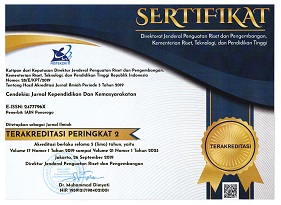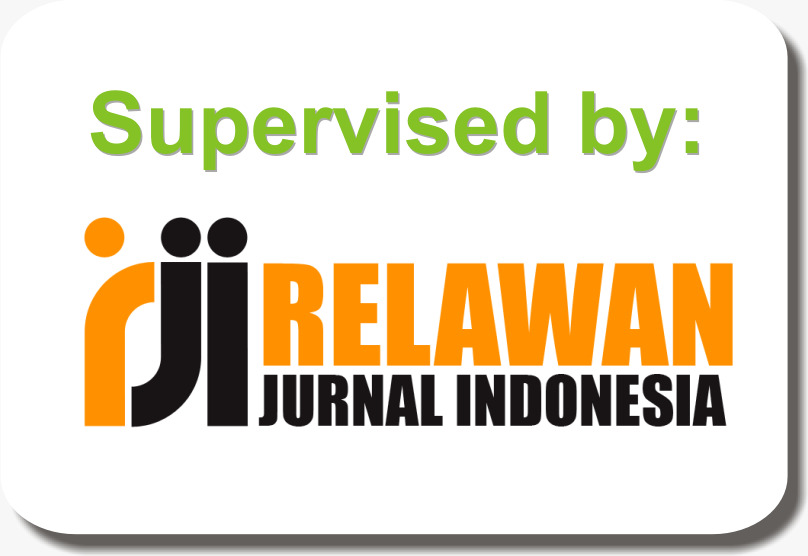Teachers’ Pedagogic Competence in Utilizing Learning Media of Islamic Religious Education at State Junior High Schools in Lhoksuemawe
DOI:
https://doi.org/10.21154/cendekia.v1i1.1818Keywords:
Pedagogic Competence, PAI, and Learning MediaAbstract
Abstrak: Penelitian ini bertujuan menjelaskan kompetensi pedagogik guru dalam pemanfaatan media pembelajaran PAI (Pendidikan Agama Islam) di SMP Negeri Lhokseumawe beserta kendala yang dihadapi guru tersebut. Penelitian ini merupakan penelitian kualitatif. Hasil penelitian menunjukkan bahwa kompetensi pedagogik guru dalam pemanfaatan media pembelajaran, pertama: Kompetensi pedagogik guru dalam merancang pelaksanaan pembelajaran dengan menggunakan media pembelajaran guna membantu mereka dalam penyampaian materi pembelajaran kepada peserta didik, kedua: kompetensi pedagogik guru dalam melaksanakan proses pembelajaran dengan menggunakan media pembelajaran adalah dapat membuat pembelajaran lebih aktif dan meningkatkan kepercayaan diri siswa dalam proses belajar mengajar. dan ketiga: kompetensi pedagogik guru dalam melakukan penilaian dengan menggunakan media pembelajaran adalah untuk memudahkan guru dalam memberi penilaian dan media yang digunakan adalah laptop dengan menggunakan aplikasi penilaian. Kendala guru dalam pemanfaatan media pembelajaran PAI di SMPN Kota Lhokseumawe adalah belum menguasai ICT, keterbatasan sarana yang akan digunakan, masalah teknis seperti mati lampu dan menyita waktu yang banyak jika tidak terampil digunakan.
الملخص: يهد٠هذا البØØ« إلى Ø´Ø±Ø Ø§Ù„ÙƒÙاءة التربوية للمعلم ÙÙŠ استخدام الوسائل التعليمية ÙÙŠ مادة التربية الإسلامية ÙÙŠ مدرسة لوكسيوماوي المتوسطة الØكومية والمشكلات التي يواجهها المعلم Ùيه. هذا البØØ« هو البØØ« النوعي. أوضØت نتائج البØØ« أن ÙƒÙاءة المعلم التربوية ÙÙŠ استخدام الوسائل التعليمية، أولاً: إن ÙƒÙاءة المعلم التربوية ÙÙŠ تصميم تنÙيذ التعليم باستخدام الوسائل التعليمية لمساعدته ÙÙŠ إيصال المواد التعليمية للطلاب، ثانياً: إن ÙƒÙاءة المعلم التربوية ÙÙŠ تنÙيذ العملية التعليمية باستخدام الوسائل التعليمية يمكن أن يجعل التعلم أكثر نشاطًا وزيادة ثقة الطلاب ÙÙŠ العملية التعليمية، وثالثًا: تتمثل ÙƒÙاءة المعلم التربوية ÙÙŠ إجراء التقييمات باستخدام الوسائل التعليمية ÙÙŠ تسهيل المعلمين ÙÙŠ تصني٠وتكون الوسائل المستخدمة وهي أجهزة الØاسوب المØمولة التي تستخدم تطبيقات التقييم. والمشكلات التي يواجهها المعلم ÙÙŠ الوسائل التعليمية ÙÙŠ مادة التربية الإسلامية ÙÙŠ مدرسة لوكسيوماوي المتوسطة الØكومية هي أنهم لم يتقنوا تكنولوجيا المعلومات والاتصالات، والمراÙÙ‚ المØدودة لاستخدامها، والمشكلات التقنية مثل انقطاع التيار الكهربائي واستهلاك الوقت إذا لم يكونوا ماهرون ÙÙŠ الاستخدام.
Downloads
Additional Files
Published
How to Cite
Issue
Section
License
Copyright & License
Please find the rights and licenses in Cendekia: Jurnal Kependidikan dan Kemasyarakatan. By submitting the article/manuscript, the author(s) agree with this policy. No specific document sign-off is required.
1. License
The non-commercial use of the article will be governed by the Creative Commons Attribution license as currently displayed on the Creative Commons Attribution-NonCommercial 4.0 International License.
2. Author(s)' Warranties
The author warrants that the article is original, written by the stated author(s), has not been published before, contains no unlawful statements, does not infringe the rights of others, is subject to copyright that is vested exclusively in the author and free of any third party rights, and that any necessary written permissions to quote from other sources have been obtained by the author(s).
3. User/Public Rights
The spirit of Cendekia: Jurnal Kependidikan dan Kemasyarakatan is to disseminate articles published as free as possible. Under the Creative Commons license, Cendekia: Jurnal Kependidikan dan Kemasyarakatan permits users to copy, distribute, display, and perform the work for non-commercial purposes. Users will also need to attribute authors and Cendekia: Jurnal Kependidikan dan Kemasyarakatan on distributing works in the journal and other media of publications. Unless otherwise stated, the authors are public entities as soon as their articles got published.
4. Rights of Authors
Authors retain all their rights to the published works, such as (but not limited to) the following rights;
- Copyright and other proprietary rights relating to the article, such as patent rights,
- The right to use the substance of the article in own future works, including lectures and books,
- The right to reproduce the article for own purposes,
- The right to self-archive the article,
- The right to enter into separate, additional contractual arrangements for the non-exclusive distribution of the article's published version (e.g., post it to an institutional repository or publish it in a book), with an acknowledgment of its initial publication in this journal (Cendekia: Jurnal Kependidikan dan Kemasyarakatan).
5. Co-Authorship
If the article was jointly prepared by more than one author, any author submitting the manuscript warrants that he/she has been authorized by all co-authors to be agreed on this copyright and license notice (agreement) on their behalf and agrees to inform his/her co-authors of the terms of this policy. Cendekia: Jurnal Kependidikan dan Kemasyarakatan will not be held liable for anything arising due to the author(s) internal dispute. Cendekia: Jurnal Kependidikan dan Kemasyarakatan will only communicate with the corresponding author.
6. Royalties
Being an open accessed journal and disseminating articles for free under the Creative Commons license term mentioned, the author(s) are aware that Cendekia: Jurnal Kependidikan dan Kemasyarakatan entitles the author(s) to no royalties or other fees.
7. Miscellaneous
Cendekia: Jurnal Kependidikan dan Kemasyarakatan will publish the article (or have it published) in the journal if the article's editorial process is completed. The editors of Cendekia: Jurnal Kependidikan dan Kemasyarakatan may modify the paper to a style of punctuation, spelling, capitalization, referencing, and usage that deems appropriate. The author acknowledges that the article may be published so that it will be publicly accessible, and such access will be free of charge for the readers, as mentioned in point 3.

















